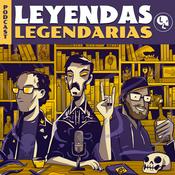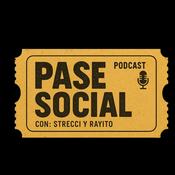85 episodios

85: Samuel Adams is Dead (Part 1)
07/1/2026 | 1 h 27 min
On a sunny fall day in 1841, New York City officials boarded a ship in search of a crate. Crew members found it buried deep in the cargo hold. The odor coming from within it was unbearable.Inside, they discovered the decomposing body of half-naked man, covered in salt. Authorities identified the body as Samuel Adams (No, not that Samuel Adams.) Who could have done such a thing? There was no need to ponder that question. Authorities had already arrested their prime suspect, John Caldwell Colt. John was an author and expert on bookkeeping. He was also the older brother of Samuel Colt, the inventor of the Colt Revolver. In this episode, Normie C hits us with all the context we’ll need to understand this gruesome murder and the bizarre trial that followed. Remember, kids, history hoes always cite their sources! For this episode, Norm pulled from: Dunphy, Thomas. Remarkable Trials of All Countries. Diossy & Company, 1870.Edwards, William. The Story of Colt’s Revolver. Stackpole Co, 1953.Phelps, M. Devil’’s Right Hand: The Tragic Story of the Colt Family Curse. Lyons Press, 2013.Schechter, Harold. Killer Colt: Murder, Disgrace, and the Making of an American Legend. 1st ed. Open Road Integrated Media, Inc, 2010.Are you enjoying An Old Timey Podcast? Then please leave us a 5-star rating and review wherever you listen to podcasts!Are you *really* enjoying An Old Timey Podcast? Well, calm down, history ho! You can get more of us on Patreon at patreon.com/oldtimeypodcast. At the $5 level, you’ll get a monthly bonus episode (with video!), access to our 90’s style chat room, plus the entire back catalog of bonus episodes from Kristin’s previous podcast, Let’s Go To Court.

84: Top 10 DB Cooper Suspects (Part 3)
17/12/2025 | 1 h 35 min
Welcome to the first annual D.B. Cooper Suspect Awards! In this very real award show, we celebrate a handful of the thin-lipped, military-trained sky divers who *might* be responsible for the only unsolved airplane hijacking in United States history. Plus: Mistakes of Shame! Kristin mispronounced the name of D.B. Cooper suspect Robert Rackstraw. She called him Robert Rackshaw. As punishment, Kristin will be banned from podcasting for the remainder of 2025.Remember, kids, history hoes always cite their sources! For this episode, Kristin pulled from: “As new evidence upends D.B. Cooper case, the (un)usual suspects continue to fuel the legend,” by Douglas Perry for The Oregonian“Who were the D.B. Cooper suspects? From Rob Rackstraw to Dick Briggs,” by Molli Mitchell for Newsweek“Five most likely suspects behind iconic D.B. Cooper mystery as net closes in on identifying him,” by Luke Kenton for The Daily Mail“Suspects in the D.B. Cooper skyjacking – sketches, pictures and comparisons,” by Bruce A. Smith for The Mountain News“D.B. Cooper letter, newly released by FBI, offers startling coded clue that might reveal skyjacker,” by Douglas Perry for The Oregonian“‘Charming’ D.B. Cooper suspect Sheridan Peterson dies at 94, spent years dedicated to political causes,” by Douglas Perry for The OregonianThe book, “Skyjack: The Hunt for D.B. Cooper,” by Geoffrey GrayThe documentary, “The Mystery of DB Cooper”“Who was the mysterious hijacker D.B. Cooper?” by Ella Morton for History.com“D.B. Cooper Hijacking, FBI.gov“The missing piece of the D.B. Cooper story,” by Andrea Marks for Rolling Stone“Scientists say they may have new evidence in the D.B. Cooper case,” by Chris Ingalls for USA TodayAre you enjoying An Old Timey Podcast? Then please leave us a 5-star rating and review wherever you listen to podcasts!Are you *really* enjoying An Old Timey Podcast? Well, calm down, history ho! You can get more of us on Patreon at patreon.com/oldtimeypodcast. At the $5 level, you’ll get a monthly bonus episode (with video!), access to our 90’s style chat room, plus the entire back catalog of bonus episodes from Kristin’s previous podcast, Let’s Go To Court.

83: The D.B. Cooper Investigation Takes Off (Part 2)
10/12/2025 | 1 h 21 min
On Thanksgiving Eve, 1971, D.B. Cooper parachuted into the night’s sky with $200k in ransom money. That night, the FBI launched their investigation into his identity and location. They interviewed eyewitnesses. They developed sketches. They searched the airplane for evidence, finding a few hairs, cigarette butts, and a clip-on tie. They analyzed the flight path to determine where he might have landed. But after searching, and searching, and searching - the mysterious D.B. Cooper was nowhere to be found. Remember, kids, history hoes always cite their sources! For this episode, Kristin pulled from: The book, “Skyjack: The Hunt for D.B. Cooper,” by Geoffrey Gray The documentary, “DB Cooper: Where are you?!” The documentary, “The Mystery of DB Cooper” “Who was the mysterious hijacker D.B. Cooper?” by Ella Morton for History.com “D.B. Cooper Hijacking, FBI.gov “The missing piece of the D.B. Cooper story,” by Andrea Marks for Rolling Stone “Scientists say they may have new evidence in the D.B. Cooper case,” by Chris Ingalls for USA Today Are you enjoying An Old Timey Podcast? Then please leave us a 5-star rating and review wherever you listen to podcasts! Are you *really* enjoying An Old Timey Podcast? Well, calm down, history ho! You can get more of us on Patreon at patreon.com/oldtimeypodcast. At the $5 level, you’ll get a monthly bonus episode (with video!), access to our 90’s style chat room, plus the entire back catalog of bonus episodes from Kristin’s previous podcast, Let’s Go To Court.

82: D.B. Cooper’s Infamous Hijacking (Part 1)
03/12/2025 | 1 h 28 min
This episode kicks off our coverage of the only unsolved airplane hijacking in United States history. On November 24, 1971, a nondescript man boarded a flight to Seattle. He wore a dark suit. He carried a briefcase. As the plane took off, he told the flight attendants that he had a bomb. He demanded $200,000 in ransom money, plus four parachutes. The airline, along with federal agents, scrambled to meet his demands. When the plane landed in Seattle, he allowed the passengers to leave. Then the man – who would later be known as D.B. Cooper – instructed the crew to fly him to Mexico. His instructions revealed a high level of knowledge about the Boeing 727 jet. And then? He did the unthinkable. He parachuted out of the plane with the ransom money in tow, never to be heard from again.Remember, kids, history hoes always cite their sources! For this episode, Kristin pulled from: The book, “Skyjack: The Hunt for D.B. Cooper,” by Geoffrey GrayThe documentary, “DB Cooper: Where are you?!”The documentary, “The Mystery of DB Cooper”“Who was the mysterious hijacker D.B. Cooper?” by Ella Morton for History.com“D.B. Cooper Hijacking, FBI.gov“The missing piece of the D.B. Cooper story,” by Andrea Marks for Rolling StoneAre you enjoying An Old Timey Podcast? Then please leave us a 5-star rating and review wherever you listen to podcasts!Are you *really* enjoying An Old Timey Podcast? Well, calm down, history ho! You can get more of us on Patreon at patreon.com/oldtimeypodcast. At the $5 level, you’ll get a monthly bonus episode (with video!), access to our 90’s style chat room, plus the entire back catalog of bonus episodes from Kristin’s previous podcast, Let’s Go To Court.

81: Blinded By The Spite: The Richardson Spite House
19/11/2025 | 1 h 47 min
Spite Houses: The architectural equivalent of a middle finger. They’re structures or dwellings designed specifically to piss someone off. This week, Norm does a deep dive into a truly ridiculous spite house, built and owned by an eccentric millionaire named Joseph Richardson. It all started when a man made an offer on Joseph’s 5-foot wide, 102-foot deep tract of land in New York City. Joseph was so offended by the man’s (completely reasonable) offer, that he built an odd, skinny structure right next to the man’s beautiful apartment building. And the wildest part of it all? Joseph Richardson lived in his spite house for fifteen years. Remember, kids, history hoes always cite their sources! For this episode, Norm pulled from: Alpern, Andrew. Holdouts!: The Buildings That Got in the Way. McGraw-Hill, 1984. Documentary History of American Water-Works. “Biography of Joseph Richardson.” http://www.waterworkshistory.us/bio/Richardson/index.htm. Find a Grave. “Joseph C. Richardson (1814-1897).” https://www.findagrave.com/memorial/58229813/joseph_c-richardson. Miller, Tom. “The Lost 1882 ‘Spite House’ -- No. 1218 Lexington Avenue.” Daytonian in Manhattan, August 27, 2012. https://daytoninmanhattan.blogspot.com/2012/08/the-lost-1882-spite-house-no-1215.html. New York Architecture. “New York Architecture Images - Spite House.” February 1, 2012. https://web.archive.org/web/20120201111125/http://www.nyc-architecture.com/GON/GON005.htm. New York Daily Herald. “Corporate Elections.” April 8, 1873. New York Daily Herald. “Marriages and Deaths.” July 14, 1872. New York Daily Herald. “The City Railroad Bills.” February 12, 1873. New York Herald. “Financial and Commercial.” March 12, 1874. New York Herald. “Railroads in Utah.” January 27, 1875. New York Herald. “‘Uncle Ben’ Richardson Dead.” February 22, 1889. New York Times. “Calls Them Embezzlers.” March 20, 1895. New York Times. “Joseph Richardson Dead.” June 9, 1897. New York Times. “Joseph Richardson Dying.” April 16, 1897. New York Times. “Meeting of the Directors of the Union Pacific Railroad.” March 7, 1873. New York Times. “Mr Richardson’s Faculty.” June 14, 1897. New York Times. “Mr. Richardson’s Funeral.” June 12, 1897. New York Times. “Richardson Will Contest.” November 18, 1897. New York Times. “Richardson’s Money Gone.” December 23, 1897. New York Times. “Spite House Case Dismissed.” November 1, 1900. New York Times. “Stormy Railroad Meeting.” October 19, 1877. New York Times. “Struck in the Tunnel.” August 21, 1888. New York Tribune. “Evicted, Goes to Country.” August 21, 1910. New York Tribune. “Rapid Transit Schemes.” September 22, 1875. The Universe of Discourse. “The Spite House.” https://blog.plover.com/tech/spite-house.html. The World. “Strange Heirs of Joseph Richardson.” June 13, 1897. Utah Rails.Net. “The History of Utah’s Railroads, 1869-1883.” https://utahrails.net/reeder/reeder-chap6.php. Valentine’s Manual of Old New York. The Chauncey Holt Company, 1921. Are you enjoying An Old Timey Podcast? Then please leave us a 5-star rating and review wherever you listen to podcasts! Are you *really* enjoying An Old Timey Podcast? Well, calm down, history ho! You can get more of us on Patreon at patreon.com/oldtimeypodcast. At the $5 level, you’ll get a monthly bonus episode (with video!), access to our 90’s style chat room, plus the entire back catalog of bonus episodes from Kristin’s previous podcast, Let’s Go To Court.
Más podcasts de Humor
Podcasts a la moda de Humor
Acerca de An Old Timey Podcast
Escucha An Old Timey Podcast, Hablemos de Tal con UnTalFredo y muchos más podcasts de todo el mundo con la aplicación de radio.net

Descarga la app gratuita: radio.net
- Añadir radios y podcasts a favoritos
- Transmisión por Wi-Fi y Bluetooth
- Carplay & Android Auto compatible
- Muchas otras funciones de la app
Descarga la app gratuita: radio.net
- Añadir radios y podcasts a favoritos
- Transmisión por Wi-Fi y Bluetooth
- Carplay & Android Auto compatible
- Muchas otras funciones de la app


An Old Timey Podcast
Descarga la app,
Escucha.




































